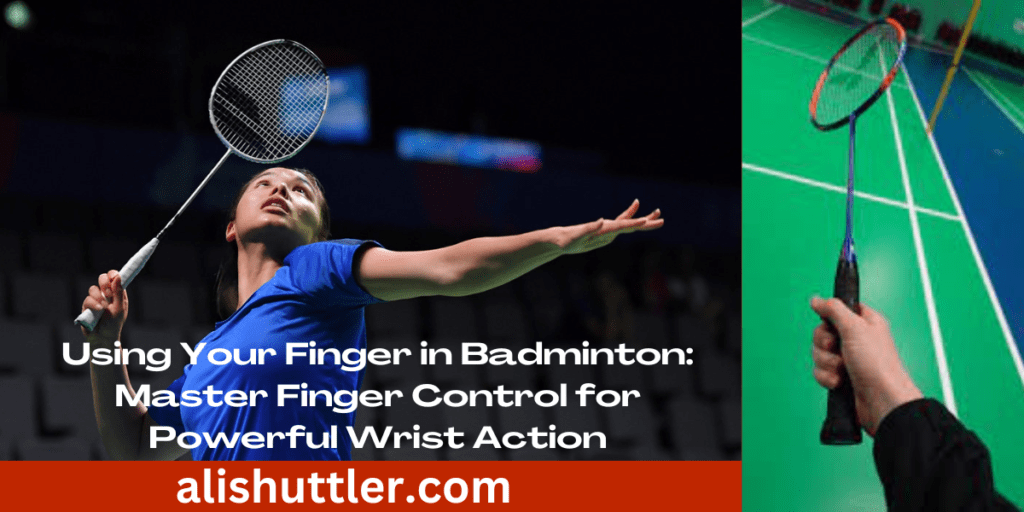Ever wondered how some players effortlessly execute precise shots in the fast-paced game of badminton? It all comes down to one crucial factor: finger control and using the right grips. Whether it’s the basic grip for forehand shots or the backhand grip for those tricky shots, having good control over using your finger in badminton is essential to mastering the game.
In the world of badminton, players who have honed their finger control possess a distinct advantage. By harnessing this skill, they are able to achieve unparalleled precision and accuracy in their shots. Whether it’s a powerful smash or a delicate drop shot, proper finger control allows players to manipulate the racket with finesse and control. This is especially important when using the basic grip or the backhand grip for forehand shots.
To excel at badminton, developing finger strength and dexterity is essential for executing various shots with ease. This enables you to maximize your potential on the court. Let’s dive into the world of finger control in badminton and discover how it can take your game to new heights, especially when using the backhand grip and forehand with the racquet grips.
Table of Contents
Proper Grip Technique for Holding a Badminton Racket
The correct grip technique is crucial when using your finger in badminton. It ensures a solid connection between the racquet and your hand, providing stability and allowing you to generate power and maintain control during forehand shots. Gripping the racquet too tightly can hinder flexibility, while gripping it too loosely may result in a loss of control over the shuttlecock.
To find the most comfortable and effective grip style for your playing style, it’s important to understand the different options available. Here are some key points to consider when it comes to finger power and using the middle finger on the racquet to control the shuttlecock.
- Badminton grip: There are various grip styles used in badminton, including the forehand grip, backhand grip, and panhandle grip. Each has its own advantages and is suitable for specific shots or situations.
- Racket handle: The size and shape of the racket handle play a significant role in finding the right grip technique. Experimenting with different handle sizes can help you determine which one feels most comfortable in your hand.
- Racquet tension: The tension of the strings on your racket also affects how you hold it. Higher string tension provides more control but requires a firmer grip, while lower tension offers more power but may require a looser hold.

Remember these tips when holding your badminton racket:
- Maintain a relaxed yet firm grip on the handle.
- Position your fingers comfortably around the racquet handle without squeezing too tightly, using the backhand grip or badminton grip to play.
- Ensure that your badminton grip is correct by making sure your thumb rests gently against the wider part of the racquet handle. This will provide added stability and improve your finger power when you play.
- Keep your wrist flexible to allow smooth movement during shots and to maximize your finger power in your badminton grip.
- Practice different grips during training sessions to find what works best for you.
By mastering proper grip techniques, you’ll enhance your performance on the badminton court while reducing the risk of injury or strain on your fingers and hand muscles.
So next time you step onto the court, make sure you have a solid understanding of how to hold your racket correctly. Your grip can make all the difference in your badminton game.
Utilizing Finger Power to Improve Performance
Engaging your fingers actively in each shot adds power and precision to your game. By incorporating finger movements into swings, you can enhance racket speed, enabling powerful smashes or accurate drop shots. This extra burst of finger power allows you to generate additional spin on shuttlecock impacts, making it harder for opponents to return shots effectively.
Developing strong fingers through targeted exercises is key to improving your ability to manipulate the racket. Consider including the following finger-strengthening routine in your training:
- Finger curls: Hold a small weight or resistance band in your hand and curl your fingers inward towards your palm. Repeat this exercise for several sets, gradually increasing the weight or resistance over time.
- Grip squeezes: Use a stress ball or grip strengthener and squeeze it tightly with all of your fingers, focusing on building strength evenly across each digit.
- Finger extensions: Place rubber bands around each finger and spread them apart against the resistance of the bands. This exercise helps improve flexibility and dexterity in your fingers.
By dedicating time to these exercises regularly, you will notice significant improvements in both finger strength and control while playing badminton.
Remember that using finger power is just one aspect of becoming a better player. It’s important to focus on other elements such as footwork, technique, and strategy as well. Incorporate these tips into your practice sessions and watch as your overall performance improves on the court.
So why not give it a try? Start utilizing the power of your fingers today and see how it transforms your game!
Mastering the Backhand Thumb Grip
The backhand thumb grip is a crucial technique for any badminton player looking to enhance their game. This grip offers excellent maneuverability and versatility when executing backhand shots. By placing the thumb behind the handle, players can quickly adjust racket angles during backhand strokes, allowing for greater control and precision.
One of the key advantages of the backhand thumb grip is its ability to provide players with increased wrist flexibility. This flexibility enables them to execute deceptive shots and cross-court clears with ease. With practice, players can master this grip, coordinating their thumb placement with the positioning of their other fingers.
To fully understand the benefits of the backhand thumb grip, it’s important to consider its impact on different aspects of your game:
- Maneuverability: The backhand thumb grip allows for swift movements and quick adjustments on the court.
- Versatility: With this grip, players have more options.
- Wrist Flexibility: The backhand thumb grip enhances wrist mobility, enabling players to generate power and accuracy with their shots.
- Coordination: Mastering this grip requires coordination between thumb placement and other fingers’ positioning.
To improve your skills at using this grip effectively, it is advisable to work closely with a coach who can provide guidance and feedback. Regular practice sessions focused on developing proper technique will help you achieve mastery over the backhand thumb grip.
Exploring the Backhand Bevel Thumb Grip
The backhand bevel thumb grip is a technique that can greatly improve your performance in badminton. By utilizing a slight rotation of the wrist, this grip provides enhanced stability during backhand shots.
With the backhand bevel thumb grip, you’ll experience precise control and accuracy, especially when executing delicate drop shots or net shots. Pro players like this grip because it helps them hit powerful shots accurately.
To find the most comfortable and effective grip for your backhand strokes, it’s important to experiment with different bevel angles. Here are some key points to consider:
- Use your forearm as a guide to position your hand correctly.
- Place your thumb on the beveled surface of the racket handle.
- Keep your palm firmly against the racket handle for added stability.
- Rotate your wrist slightly to engage the backhand bevel thumb grip.
By following these steps and practicing regularly, you’ll gradually develop a strong backhand using this technique. Remember that finding the right angle and rest position for your hand is crucial to achieving optimal results.
Fine-Tuning Finger Technique for Control and Accuracy
Developing finger sensitivity is a key technique in badminton that allows players to make precise adjustments to shot placement. By honing their finger control, players can maintain a consistent racket face angle, resulting in accurate shots. Here are some tips to improve your finger technique:

- Practicing Finger Drills: Regularly incorporating finger drills into your training sessions can enhance muscle memory and overall control over the racket. These drills can involve exercises that focus on improving the dexterity of your index finger, which plays a crucial role in shot execution.
- Shot Placement: Focusing on finger positioning during swings is essential for improving shot precision. This becomes particularly important when executing tight net shots or cross-court drives. By using your fingers to guide the racket, you can direct the shuttlecock with greater accuracy towards specific locations on the court.
- Consistency: Maintaining a consistent racket face angle is vital for achieving accurate shots. Your fingers play a significant role in controlling this angle throughout your swing. Practice keeping a steady grip pressure and pay attention to how your fingers interact with the racket handle.
- Muscle Memory: By repeatedly practicing proper finger technique, you develop muscle memory that allows you to execute shots more instinctively and precisely over time. This muscle memory helps you achieve better control and accuracy during intense rallies.
using your finger in badminton: Conclusion
To maximize power in your badminton game, mastering finger techniques is essential. By employing proper grip techniques, such as the backhand thumb grip and the backhand bevel thumb grip, you can significantly improve your performance on the court. These grips allow you to generate more power and control over your shots.
Utilizing finger power not only enhances your ability to hit powerful smashes but also improves your overall control and accuracy. By fine-tuning your finger technique, you can achieve better shot placement and execute precise shots with ease.
In conclusion, using your fingers effectively in badminton can greatly elevate your game. By implementing the various finger techniques discussed, you will experience a noticeable improvement in both power and precision. So don’t hesitate to practice these techniques and incorporate them into your gameplay.
Remember that consistency is key when developing new skills. Dedicate time to perfecting these finger techniques through regular practice sessions. With perseverance and determination, you’ll witness significant progress in no time.
Now it’s time for you to put these finger techniques into action! Start incorporating them into your training routine and observe how they positively impact your badminton performance.
FAQs
Q: Can I use finger techniques even if I’m a beginner?
A: Absolutely! Finger techniques are beneficial for players of all skill levels. They may require some practice initially, but they will undoubtedly enhance your game once mastered.
Q: Are there any specific exercises to strengthen my fingers for badminton?
A: While there aren’t any specific exercises solely focused on finger strength for badminton, regular racket handling drills and gripping exercises can help improve overall hand strength.
Q: How long does it take to master these finger techniques?
The time required to master these techniques varies from person to person. It depends on factors such as individual aptitude, practice frequency, and dedication. Consistent practice over several weeks or months can lead to significant improvement.
Q: Can finger techniques help with my backhand shots?
A: Yes, absolutely! The backhand thumb grip and the backhand bevel thumb grip discussed in this guide are specifically designed to improve your backhand shots. They provide better control and power for executing effective backhand strokes.
Q: Are there any risks or injuries associated with using finger techniques?
When performed correctly, finger techniques do not pose any significant risks or injuries. However, it’s essential to maintain proper form and avoid excessive strain on your fingers and hand muscles to prevent potential discomfort or injury.
Q: Can I combine different finger techniques during a game?
A: Yes, you can experiment with different finger techniques based on the situation during a game. It’s important to adapt your grip according to the shot you want to execute for optimal results.
Q: Do professional badminton players use these finger techniques?
A: Yes, professional badminton players often utilize various finger techniques to maximize their performance on the court. These techniques are used by top players worldwide.

